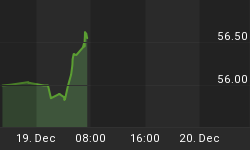The only thing remarkable about the recent rally in U.S. equities is how unremarkable it has been. To be sure, you would think that with the 'worst' being 'over' stocks would be able to mount a significant bounce. This hasn't been the case, at least not yet.

To put the above rally in perspective, during the last bear market the S&P 500 notched 3-notable rallies before finally reaching a bottom. Assuming the October 9, 2007 S&P 500 close of 1565.15 proves a 'top' and/or we are in a bear market (which has not been confirmed on a closing basis), today's 11% jump is exceptionally weak by comparison.

Incidentally, there is the argument - recently explored by Russell the revisionist - that stocks are still in a long-term bull market. However, what quickly busts this theory is common sense: for the 7½ years ending October 9, 2007 the S&P 500 gained a total of 2.5%! Does this price action really represent the continuation of the 1982-2000 bull market? (Russell the realist would no doubt remind us that the 2.5% gain in the S&P 500 from March 24, 2000 to October 9, 2007 translates into a significant decline when priced in most non-USD currencies).
Leaving the realm of bulls and bears, it may be important to note that the current market rally is backed by some potentially potent near-term drivers. First and foremost, the yield on so called 'sidelined' capital (primarily parked in money market funds) has reached a point where it doesn't match inflation. Some market timers think - a la Greenspan's 2003 trick - that this means the Fed has reduced interest rates low enough to entice some of this money back into equities. Next, volatility is showing signs of trending down, and with the Fed essentially guaranteeing the survival of any party too 'interconnected' to fail it is plausible that we have entered a period of calm.

Finally, the shorts, which aggressively covered some of their positions following the Bear Stearns bailout, are still holding a historically high short position. If a major move higher transpires these shorts could be burned, adding some volume to the buy side of the equation.

Is the 'sidelined'/VIX/short selling story reason enough to buy stocks now? Unfortunately no. Rather, the more pressing story is that as the Fed tries to hit the reset button on the credit bubble the U.S. economy is threatening to go tilt. Quite frankly, even if you assume that the Fed will be entirely successful in its efforts to stimulate lending and bring risk taking back to the financial markets, there is the real risk that dangerous amounts of inflation are sticking in the system (if the period of creative destruction that is ongoing in the housing market and structured finance markets is not enough to quell the inflation monster what are the odds that U.S. stock market and economic rebound in the latter half of 2008 will do the trick?) When you combine these uncertainties with the unattractive market valuations it is clear that pinball wizards need only apply to the speculative bets being made in equities today.
In short, the mayhem that erupted in late 2007/early 2008 has indeed calmed, but many years will likely have to pass before it is removed. With the Fed, U.S. government, and U.S. consumer forced to adopt emergency measures to simply keep up the norm a little while longer, those that cheer the relief rallies and unsustainable economic bounces may end up doing so at their peril.
"The increase in consumer debt totaled $15.3 billion at an annual rate in March, much bigger than the $6 billion increase that economists had been expecting. The bigger gain was seen as a sign that the weaker economy was forcing consumers to increase their borrowing to support spending..." AP ~ FED















